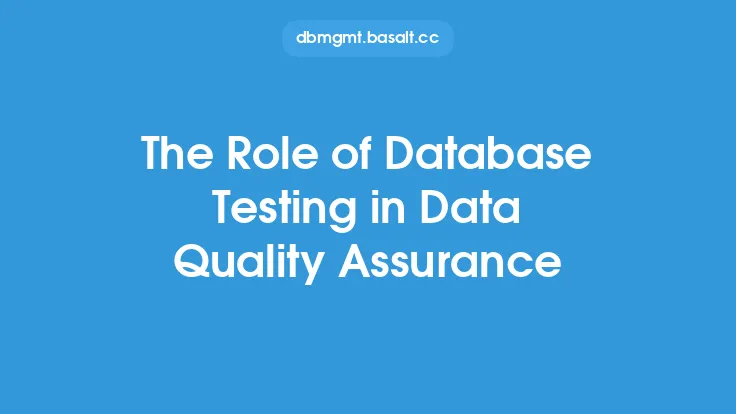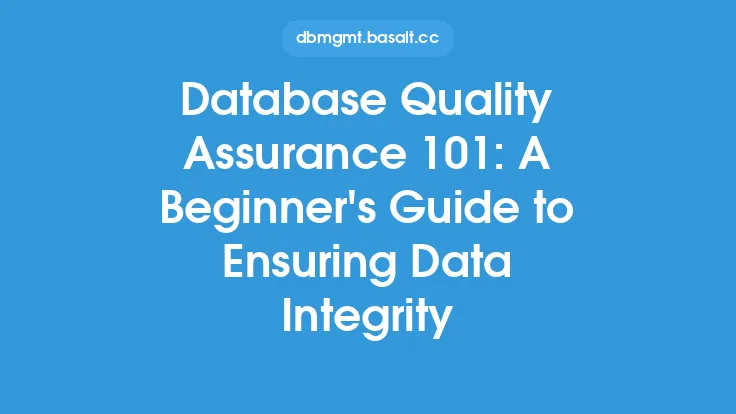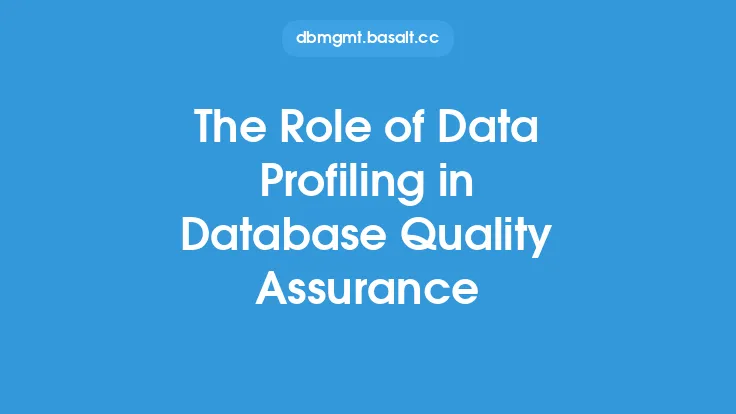Database quality assurance is a critical aspect of database administration, ensuring that the data stored in a database is accurate, complete, and consistent. One of the key components of database quality assurance is the use of specialized tools designed to help database administrators and developers identify and fix data quality issues. In this article, we will compare and contrast some of the top database quality assurance tools available, highlighting their features, strengths, and weaknesses.
Introduction to Database Quality Assurance Tools
Database quality assurance tools are software applications that help database administrators and developers to identify, analyze, and fix data quality issues in a database. These tools can be used to perform a variety of tasks, including data validation, data profiling, data cleansing, and data transformation. They can also be used to monitor data quality in real-time, allowing for quick identification and resolution of data quality issues. Some of the key features of database quality assurance tools include data quality metrics, data validation rules, data profiling, and data cleansing capabilities.
Types of Database Quality Assurance Tools
There are several types of database quality assurance tools available, each with its own strengths and weaknesses. Some of the most common types of database quality assurance tools include:
- Data validation tools: These tools are used to validate data against a set of predefined rules, ensuring that the data is accurate and consistent.
- Data profiling tools: These tools are used to analyze data and identify patterns, trends, and relationships.
- Data cleansing tools: These tools are used to identify and fix data quality issues, such as missing or duplicate data.
- Data transformation tools: These tools are used to transform data from one format to another, ensuring that it is consistent and accurate.
- Data quality metrics tools: These tools are used to measure and track data quality metrics, such as data completeness and data consistency.
Comparison of Top Database Quality Assurance Tools
Some of the top database quality assurance tools available include:
- Talend: Talend is a comprehensive data integration platform that includes a range of database quality assurance tools, including data validation, data profiling, and data cleansing capabilities.
- Informatica: Informatica is a data integration platform that includes a range of database quality assurance tools, including data validation, data profiling, and data transformation capabilities.
- SAP Data Services: SAP Data Services is a data integration platform that includes a range of database quality assurance tools, including data validation, data profiling, and data cleansing capabilities.
- Oracle Enterprise Data Quality: Oracle Enterprise Data Quality is a comprehensive data quality platform that includes a range of database quality assurance tools, including data validation, data profiling, and data cleansing capabilities.
- Microsoft SQL Server Data Quality Services: Microsoft SQL Server Data Quality Services is a data quality platform that includes a range of database quality assurance tools, including data validation, data profiling, and data cleansing capabilities.
Features and Strengths of Top Database Quality Assurance Tools
Each of the top database quality assurance tools has its own unique features and strengths. For example:
- Talend includes a range of data integration tools, including data validation, data profiling, and data cleansing capabilities.
- Informatica includes a range of data transformation tools, including data mapping, data conversion, and data aggregation capabilities.
- SAP Data Services includes a range of data quality metrics tools, including data completeness, data consistency, and data accuracy metrics.
- Oracle Enterprise Data Quality includes a range of data validation tools, including data format validation, data range validation, and data consistency validation.
- Microsoft SQL Server Data Quality Services includes a range of data profiling tools, including data distribution analysis, data correlation analysis, and data trend analysis.
Weaknesses and Limitations of Top Database Quality Assurance Tools
Each of the top database quality assurance tools also has its own weaknesses and limitations. For example:
- Talend can be complex and difficult to use, requiring a significant amount of training and expertise.
- Informatica can be expensive, requiring a significant investment in software and hardware.
- SAP Data Services can be limited in its ability to handle large and complex datasets.
- Oracle Enterprise Data Quality can be inflexible, requiring a significant amount of customization and configuration.
- Microsoft SQL Server Data Quality Services can be limited in its ability to integrate with other data quality tools and platforms.
Choosing the Right Database Quality Assurance Tool
Choosing the right database quality assurance tool depends on a variety of factors, including the size and complexity of the database, the type of data being stored, and the level of data quality required. Some of the key considerations include:
- Data quality requirements: What level of data quality is required, and what types of data quality issues need to be addressed?
- Database size and complexity: How large and complex is the database, and what are the performance requirements?
- Integration requirements: What other data quality tools and platforms need to be integrated with the database quality assurance tool?
- Cost and budget: What is the budget for the database quality assurance tool, and what are the total cost of ownership and return on investment?
Best Practices for Implementing Database Quality Assurance Tools
Implementing database quality assurance tools requires a structured approach, including:
- Defining data quality requirements: What level of data quality is required, and what types of data quality issues need to be addressed?
- Selecting the right tool: What database quality assurance tool is best suited to the needs of the organization?
- Configuring and customizing the tool: How will the tool be configured and customized to meet the needs of the organization?
- Training and support: What training and support will be required to ensure that the tool is used effectively?
- Monitoring and maintenance: How will the tool be monitored and maintained to ensure that it continues to meet the needs of the organization?
Conclusion
Database quality assurance tools are a critical component of database administration, ensuring that the data stored in a database is accurate, complete, and consistent. By comparing and contrasting the top database quality assurance tools available, organizations can make informed decisions about which tool is best suited to their needs. By following best practices for implementing database quality assurance tools, organizations can ensure that their data is of the highest quality, and that their database quality assurance tool is used effectively to support their business goals.





